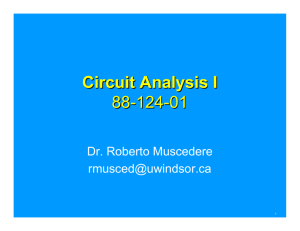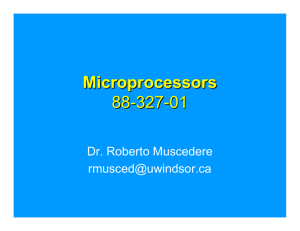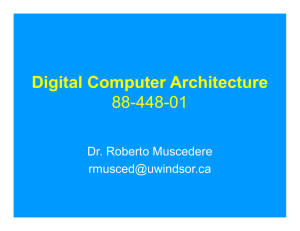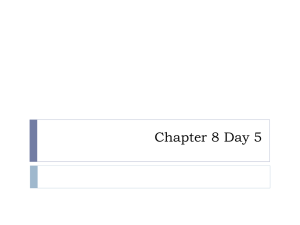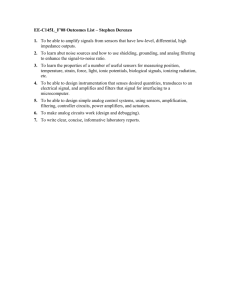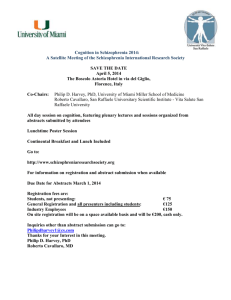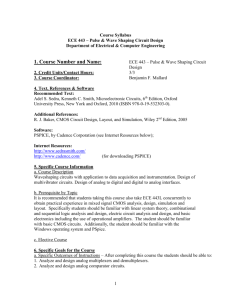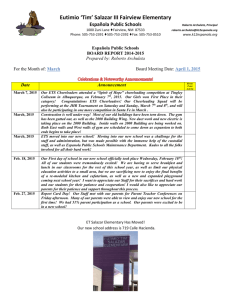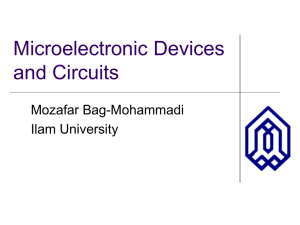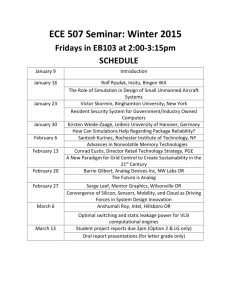Analog Integrated Circuit Design 88-444-01
advertisement
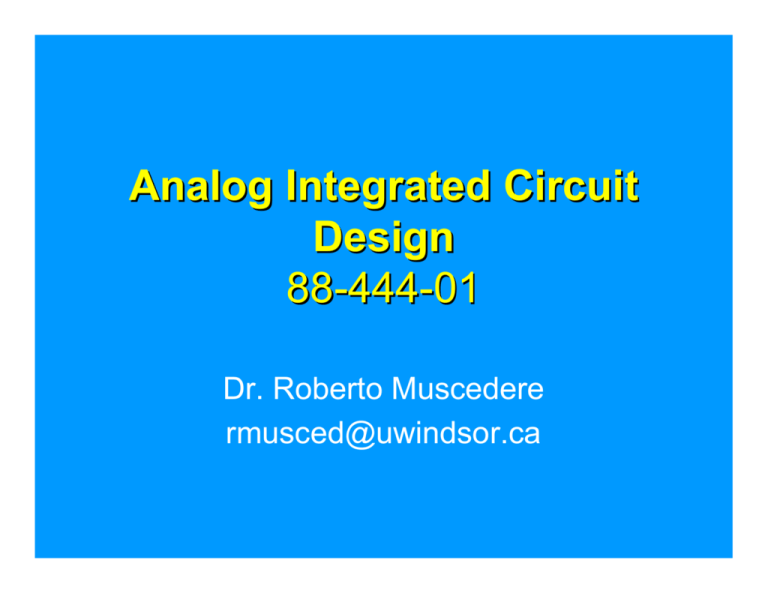
Analog Integrated Circuit Design 88-444-01 Dr. Roberto Muscedere rmusced@uwindsor.ca Who is Roberto Muscedere? • Roberto Muscedere (Moo-shed-er-ay) • “Sir” also works • Some people use Dr. Roberto • Education (University of Windsor) • Undergraduate (1992-1996) • Masters (1996-1999) • Ph.D. (1999-2003) © 2003-2015 Roberto Muscedere 2 Who is Roberto Muscedere? • Expertise • • • • VLSI/ASIC Design System Level Design Full and Semi Custom Hardware Implementation Number Systems • Only Human • I make mistakes too • If something I say doesn’t make sense, challenge me – you will probably be right © 2003-2015 Roberto Muscedere 3 Where is Roberto Muscedere? • CEI • Room 3040 • Office Hours • Have 3 young kids – there is no schedule – ever! • Please email me to set up an appointment © 2003-2015 Roberto Muscedere 4 Analog IC Design (Course Calendar) • Bipolar and CMOS technology • CMOS analog circuit modeling, CMOS device characterization • Analog Building Blocks: • Current sinks, sources and mirrors • Current, differential, and operational amplifiers • • • • • • Comparators A/D converters Multipliers Wave-shaping Low voltage and low power CAD tools © 2003-2015 Roberto Muscedere 5 Analog IC Design • We live in an analog world! • All electronic circuits are analog – even the digital ones • “Digital” circuits have a higher tolerance for noise • They use a range of signals to imply only two possible values, 0 or 1 • However, excessive noise will cause digital circuits to fail – and they fail badly © 2003-2015 Roberto Muscedere 6 Analog IC Design • Digital circuits are generally used for processing type applications • For example: microprocessor • We design digital circuits using digital building blocks • For example: AND, OR, XOR, NOT gates • We add “memories” to extend functionality • For example: Flip-Flop, Latches, Memory © 2003-2015 Roberto Muscedere 7 Analog IC Design • When building a “Digital” circuit today, we: • • • • • • • • • • Develop the functionality Use Verilog or VHDL to code the circuit Simulate it to test the functionality Synthesize it into gates Simulate again Partition, Place, and Route Check timing Simulate again Fabricate (or we use FPGAs) Circuit should work by this point © 2003-2015 Roberto Muscedere 8 Analog IC Design • When building an “Analog” circuit today, we: • Develop the functionality with building blocks in mind • Build the circuit using analog building blocks • Test circuit • Fabricate • Test fabricated circuit • Probably fabricate again (CMOS) • Circuit doesn’t always work since our models don’t reflect everything about the process © 2003-2015 Roberto Muscedere 9 Analog IC Design • Analog design is more difficult since we can not directly map our design into gates • We must map the building blocks into our design • Good analog designers are experienced (over 10 years) • Highest paid IC designers © 2003-2015 Roberto Muscedere 10 Analog IC Design • Common Analog Circuits: • • • • • • Amplifier A/D Converter D/A Converter Comparator Multiplier Clock synthesisers © 2003-2015 Roberto Muscedere 11 Analog IC Design • Designing in CMOS is preferred since it is cheaper (less fabrication steps) than in a Bipolar process • However, design time is much longer! • Bipolar is still used (GaAs, SiGe) for high performance circuits (RF) • Bipolar is not used for “digital” designs since it consumes a lot of power – but if it were, the circuits would be considerably faster than CMOS • BiCMOS processes available (CMOS and bipolar) © 2003-2015 Roberto Muscedere 12 Questions? © 2003-2015 Roberto Muscedere 13 Chip Design • Gennum GA911 Array • Deadline Early Feb! • 2 Week fabrication time • Must test your chips! © 2003-2015 Roberto Muscedere 14 Chip Design © 2003-2015 Roberto Muscedere 15 Course Schedule • Lectures (3.0 hours/week) • Mondays and Wednesdays • 10:00am to 11:20am • CE2101 • Attendance is not mandatory, but recommended © 2003-2015 Roberto Muscedere 16 Course Schedule • Laboratories (3 hours/week!) • Wednesdays from 4:00pm to 6:50pm • CE2105C - Labs • Attendance is mandatory for chip design © 2003-2015 Roberto Muscedere 17 Grade Distribution • Laboratory/Chip Design: 30% • Mid-Term Exam: 30% • Final Exam: 40% • Exam grades are based on relative student performance © 2003-2015 Roberto Muscedere 18 Prerequisite • Fourth Year Standing • Electronics I (88-226) • Electronics II (88-316) • How much was really covered in Electronics I and Electronics II? • PN Junctions • Diodes • Transistors (CMOS/Bipolar) © 2003-2015 Roberto Muscedere 19 Learning Outcome • Review and understand PN junctions • Introduce Bipolar transistors (maybe CMOS) • Understand analog building blocks • Use building blocks for larger circuits • For serious design, you will need to go into graduate school © 2003-2015 Roberto Muscedere 20 Text Book • Microelectronic Circuits (5th Edition) • Sedra/Smith (0-19-514251-9) • Same book used in 88-226 • $170 (+tax) at U of W Bookstore • A lot cheaper on-line (Amazon, etc.) © 2003-2015 Roberto Muscedere 21 Examinations • Mid-Term Exam • Week of February 9th or February 23rd , 2015 • Location and Time TBA • Final Exam • Wednesday April 20th, 2015 at 8:30am • Location TBA • Covers all material (mostly second half) © 2003-2015 Roberto Muscedere 22 Course Notes • All course information will be posted on the course website • http://www.uwindsor.ca • • • • • Select “Current Students” Select “Class Notes” Select “Engineering – Electrical Engineering” Select “88-444-01” (Dr. Muscedere) Follow to course website © 2003-2015 Roberto Muscedere 23 Web Site • Course Outline • Graduate Assistants Hours and Locations • Lectures • http://courses.muscedere.com © 2003-2015 Roberto Muscedere 24 Questions? © 2003-2015 Roberto Muscedere 25
